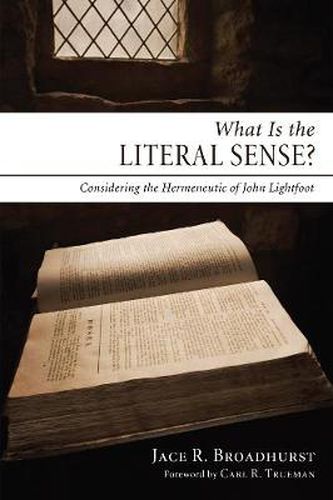Readings Newsletter
Become a Readings Member to make your shopping experience even easier.
Sign in or sign up for free!
You’re not far away from qualifying for FREE standard shipping within Australia
You’ve qualified for FREE standard shipping within Australia
The cart is loading…






This title is printed to order. This book may have been self-published. If so, we cannot guarantee the quality of the content. In the main most books will have gone through the editing process however some may not. We therefore suggest that you be aware of this before ordering this book. If in doubt check either the author or publisher’s details as we are unable to accept any returns unless they are faulty. Please contact us if you have any questions.
Invariably, people who read Scripture are forced to answer the question, What is the ‘literal sense’? This question is not new. In the seventeenth century, John Lightfoot–signer of the Westminster Confession of Faith and a master of Hebrew and of rabbinic writings–wrestled with the same question, and his conclusions had a profound impact in the world of hermeneutics. In an age of much animosity towards the Jews, Lightfoot embraced the insights found in the Jewish writings while staying grounded in his reformational dogmatic theology. In so doing, his exegesis could properly be considered a via media between Reformed Scholasticism and Judaism. Lightfoot’s hermeneutical principles and presuppositions outlined in this book not only provide valuable insight into his thinking but also reject the previously normative notion that Reformed Scholasticism has little to offer dogmatically or exegetically. The current tensions between systematic and biblical theology, the rise of interest in Second Temple and medieval Judaica, and the never-ending question of biblical authority make What Is the Literal Sense? an important read.
$9.00 standard shipping within Australia
FREE standard shipping within Australia for orders over $100.00
Express & International shipping calculated at checkout
Stock availability can be subject to change without notice. We recommend calling the shop or contacting our online team to check availability of low stock items. Please see our Shopping Online page for more details.
This title is printed to order. This book may have been self-published. If so, we cannot guarantee the quality of the content. In the main most books will have gone through the editing process however some may not. We therefore suggest that you be aware of this before ordering this book. If in doubt check either the author or publisher’s details as we are unable to accept any returns unless they are faulty. Please contact us if you have any questions.
Invariably, people who read Scripture are forced to answer the question, What is the ‘literal sense’? This question is not new. In the seventeenth century, John Lightfoot–signer of the Westminster Confession of Faith and a master of Hebrew and of rabbinic writings–wrestled with the same question, and his conclusions had a profound impact in the world of hermeneutics. In an age of much animosity towards the Jews, Lightfoot embraced the insights found in the Jewish writings while staying grounded in his reformational dogmatic theology. In so doing, his exegesis could properly be considered a via media between Reformed Scholasticism and Judaism. Lightfoot’s hermeneutical principles and presuppositions outlined in this book not only provide valuable insight into his thinking but also reject the previously normative notion that Reformed Scholasticism has little to offer dogmatically or exegetically. The current tensions between systematic and biblical theology, the rise of interest in Second Temple and medieval Judaica, and the never-ending question of biblical authority make What Is the Literal Sense? an important read.